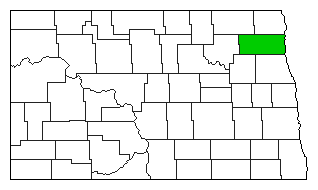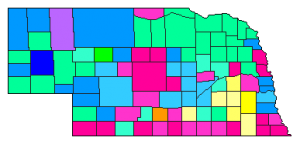Walsh County, ND data for 2012 have been updated on the atlas to reflect the recanvass of the results by the County Auditor in April, 2013. The Auditor said that there were insufficient ballots printed for the 2012 General Election, and to accommodate the voters, photocopies were made and then hand counted. This resulted in some confusion and the results were recanvassed in April of 2013. The net result was a small decrease in the official totals across all offices and all candidates. Romney’s net vote dropped by 157 from 2,813 to 2,656 and Obama lost 139 votes from 2,124 to 1,985. Similar vote reductions occurred for candidates for U.S. Senate, U.S. House of Representative, and Governor.
Monthly Archives: May 2014
Nebraska 2014 Republican Gubernatorial Primary
The Nebraska 2014 Republican Gubernatorial Primary was a competitive six-way contest with a very flat result. No candidate received more than 27% of the vote, four candidates received more than 19%, and every one of the six candidates won in at least one county. Omaha businessman Pete Ricketts came out on top with a preliminary unofficial total of 26.5% (57,922 votes), followed closely by Nebraska Attorney General Jon Bruning at 25.49% (55,751 votes), State Senator Beau McCoy at 20.94% (45,804 votes), and State Auditor Mike Foley with 19.22% (42,029 votes). Trailing were Tax attorney Bryan Slone with 4.13% and State Senator Tom Carlson with 3.74%. Across the state, only three counties were won with more than 40% of the vote – the top one being Phelps County won by fifth place finisher Carlson with 49.7% (his home town is Holdrege located in Phelps County), Ricketts won Morrill County (in the panhandle) with 42%, and Foley won Lancaster County with 41%. The table below summarizes the results:
Nebraska 2014 Republican Primary Results (Unofficial)
| Candidate | Total Votes | Percentage | Counties Won | |
|---|---|---|---|---|
 | Pete Ricketts | 57,922 | 26.48% | 26 |
 | Jon Bruning | 55,751 | 25.49% | 32 |
 | Beau McCoy | 45,804 | 20.94% | 27 |
 | Mike Foley | 42,029 | 19.22% | 7 |
 | Tom Carlson | 9,034 | 4.13% | 1 |
 | Bryan Slone | 8,179 | 3.74% | 1 |
The Pie chart at right is the statewide breakdown of the vote for the six candidates. Rickett’s strongest vote margins were in the Omaha area of Douglas and Sarpy Counties, where he had a combined margin advantage of 5,427 votes. Fourth-place finisher, Foley, had the highest-margin county in Lancaster, where he topped Bruning by 5,986 votes and Ricketts by 6,363 votes. However, he did not have sufficient state-wide support to achieve victory. Bruning’s support was more dispersed, winning the most counties, concentrated in the north and west, but not having any high-margin counties. McCoy is similar to Bruning, with his support concentrated in the central and southern portions of the state. Carlson and Slone both had more than 30% support in only a single county each. Below is a full interactive mouse-over map.
Polk County has the smallest win percentage, where Bruning won with 310 votes (24.12%) to 306 for Foley, 302 for Ricketts, 299 for McCoy, Carlson at 50, and Slone at 18. An almost even 4-way split! The full results page on the atlas is located here.
New Election Data Sets for U.S. House 1992-1998
Now available for purchase are election data sets for U.S. House of Representatives by county, congressional district, and state in the general elections of 1992, 1994, 1996, and 1998. There have been many requests for these data, and after several months of compilation, the files are now available for purchase on the store page.
Note that the status of the files is listed as “Preliminary” because the Commonwealth of Pennsylvania did not publish official results by county for U.S. House of Representatives in those years. The data included in the files in a mix of official results obtained from a few individual counties and compiled results from a precinct-level database provided by the Pennsylvania Bureau of Commissions, Elections and Legislation – but like many such databases, there are many discrepancies. It will take several more months to track down the individual results from each of the county election agencies. The data as-is is quite usable since most of the discrepancies are a small percentage of the totals.
As always, updates to purchased data sets are free.






